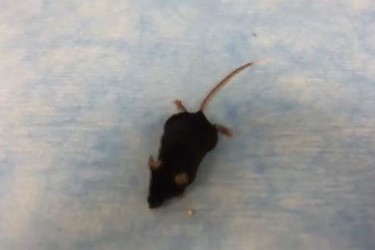PreClinical Video Aims To Attract Patients

By Ed Miseta, Chief Editor, Clinical Leader

Spherix was launched in 1967 as a scientific research company. Today, it is an intellectual property company committed to advancing innovation in all areas of the patent market. The company moved into the pharmaceutical space in October 2018 when it announced it would merge with CBM BioPharma. With that announcement, company president, CEO, and director, Anthony Hayes, suddenly found himself with the surprising challenge of taking a promising new molecule from animal testing through to clinical trials in humans and, ultimately, FDA approval.
“A lot of people will tell you that running a drug discovery company involves juggling a lot of interests,” says Hayes. “I think that's correct, but I would take the analogy one step further. It's like juggling a bowling ball, a bowling pin, and a lighted torch. When juggling three balls, you have a situation where all three interests are aligned. In this industry, I think you have some amount of natural friction between the interests you are juggling.”
 Hayes points to communication as one example. In pharma, you must understand the disease, the effect it has on patients, the treatment, and its mechanism of action. But it’s not enough to understand just that. You also have to be able to communicate it to others. Companies have investors and shareholders, and Hayes states it can be a challenge to communicate the opportunity to these stakeholders in a way they can understand and get excited about.
Hayes points to communication as one example. In pharma, you must understand the disease, the effect it has on patients, the treatment, and its mechanism of action. But it’s not enough to understand just that. You also have to be able to communicate it to others. Companies have investors and shareholders, and Hayes states it can be a challenge to communicate the opportunity to these stakeholders in a way they can understand and get excited about.
“Everyone in the industry knows the drug development process can be slow,” says Hayes. “It’s not possible to put together a pre-IND in two minutes and get it approved so you can move forward. The process takes time and everybody seems to want things done yesterday. If you announce that you’re putting a preclinical program together, within hours someone will ask when you will have the results. It’s hard to get people to understand that this is not a computer. You can’t input a formula and have it kick out an answer. Patience is a virtue. One challenge for us will be getting people to understand this is a process.”
Hayes understands the desire for immediate results. Investors are trying to understand if he has an effective compound, if they should get behind it, and if they should continue to support his company’s efforts. Every company moving into clinical trials on humans will also have to face the challenge of attracting patients to the study. These challenges can be difficult, but Hayes believes a 90-second video Spherix has in its possession will help the company overcome both.
A Video Attracts Investors
The video, which can be seen on the Spherix website, shows a mouse with the onset of hind limb paralysis from Acute Lymphoblastic Leukemia (ALL). The mouse is clearly having difficulty moving its hind legs. Just 24 hours later, after receiving one treatment, it seems to be moving more freely. After 48 hours and a second injection, the mouse appears to be moving normally.
“The mouse video was something people noticed,” states Hayes. “It can be very difficult to take the science behind your medicine and translate it into a press release that most people can read and understand. You must walk a fine line. You can't make it too complicated. But if you make it too simple, people will think you don't know what you're doing. The audience for any information you put out can really run the gamut. A company analyst might fully understand the more technical aspects of your research while a short-term investor might prefer a much simpler overview. The video is understandable. A mouse has hind leg paralysis and after two treatments is suddenly able to walk.”
The drug Spherix is hoping to take through clinical trials is KPC34. KPC34 was developed at the Wake Forest School of Medicine and is a next-generation treatment designed to overcome multiple resistance challenges observed with the current standard of care in patients with Acute Myeloid Leukemia (AML) and ALL. KPC34 has also been shown to be more effective in AML relapse cases, notably increasing the lifespan of mice treated with the drug. The drug can be orally administered, a feature that is critical for patients who are unable to tolerate repeated cycles of chemotherapy. In rodent models with leukemia, it has been shown to double the mean survival time versus the current standard of care. Spherix is working with Wake Forest as a co-developer of the drug.
“Dr. Greg Kucera and Dr. Tim Pardee at Wake Forest had been testing KPC34 for other indications,” says Hayes. “One day they decided to see what impact it might have on rear hind leg paralysis, which is common in mice with late stage AML. The video they produced showed their hunch was correct. Anybody, whether it’s a Ph.D. in chemistry or a lay person walking down the street, can look at that video and see the amazing effect.”
The next steps for Spherix will be designing the Phase 1 and Phase 2 clinical trials. Wake Forest has already thought about those next steps and is helping Spherix work on a plan. Spherix is also providing funding to move additional preclinical trials forward. Wake Forest will be able to run the Phase 1with the involvement of Dr. Kucera and Dr. Pardee, which Hayes notes is a big plus for the company.
Communicating results and information is also something Hayes is focused on. “Oftentimes, these drugs do much more than we are able to say,” he states. “Our ability to communicate is limited. Two pages of results is normally too much. The maximum amount of information you normally share is one page, single spaced. If you produce a long press release, people will not read it.”
The Move To Pancreatic Cancer
Until now, KPC34 has been focused on leukemia. Looking forward, Hayes believes the mechanism of action will also make it a candidate to treat patients with pancreatic cancer, which he describes as a horrible and depressing disease. Steve Jobs, Michael Landon, Patrick Swayze, and Aretha Franklin are just a few of the celebrities who have succumbed to the disease. Still, most people know very little about it. Five years after diagnosis, only eight percent of patients are still alive. For most patients, by the time the disease manifests itself, it's too late to save them.
“It’s a horrible cancer and we believe this drug, which is doing great things in preclinical studies for leukemia, could potentially treat these patients as well,” notes Hayes. “To me, that crossover is huge. We have the opportunity to bring a new treatment to a patient population that has limited treatment and limited hope. It has the potential to save lives and ease suffering.”
The treatment itself also brings a patient-centric approach to those battling cancer. With most cancer treatments, patients receive the treatment intravenously via an IV drip. KPC34 is an oral medication. That's helpful, especially for elderly patients. Hayes believes this is a huge value proposition.
When the treatment moves into testing on humans, Spherix will have to find patients for the study. Animal testing was performed at Wake Forest, and Wake Forest has stated a desire to perform the Phase 1 testing. The clinic at Wake Forest has a steady flow of patients, which would help to speed the development process.
“Working with Wake Forest is almost like a turnkey solution,” says Hayes. “We literally have to produce the contracts and dot the I's and cross the T's. Wake Forest is prepared to do a chunk of the heavy lifting, which speaks volumes about the program they have in place and the quality of this product.”
The Video Will Drive Interest
The video has certainly been critical in driving investor and patient interest in KPC34. Moving forward, it will continue to play a role. Investors view the video and see the commercial potential of the drug. When patients and advocacy groups see it, they will realize the treatment presents real hope for patients in need. Thus far, that has not happened.
“I tell my people that we are like a tree that fell in the woods and nobody heard it,” says Hayes. “When you watch that video, you are just amazed by what you see. And yet I'm incredibly frustrated because I feel it is not getting the attention it deserves. People can challenge the mechanism of action and at times I find myself blue in the face explaining what the drug can do. The video speaks for itself. Unless you believe the video was faked, you must believe the drug works. This is an early stage drug, but the video demonstrates the most objective evidence I have ever seen of the effectiveness of an early stage drug.”
“Initially I found it hard to believe myself,” adds Hayes. “The first time I saw it, I thought either the mouse’s name was Lazarus, or it was fake. When I started sharing it with others, I got similar reactions. Even our board members had to ask, ‘Are you sure about this?’ Thus far, no one has suggested the video is not real. But that sentiment is expressed in more subtle ways. For that reason, I can confidently tell people, Yes, I’m sure this is real.”
